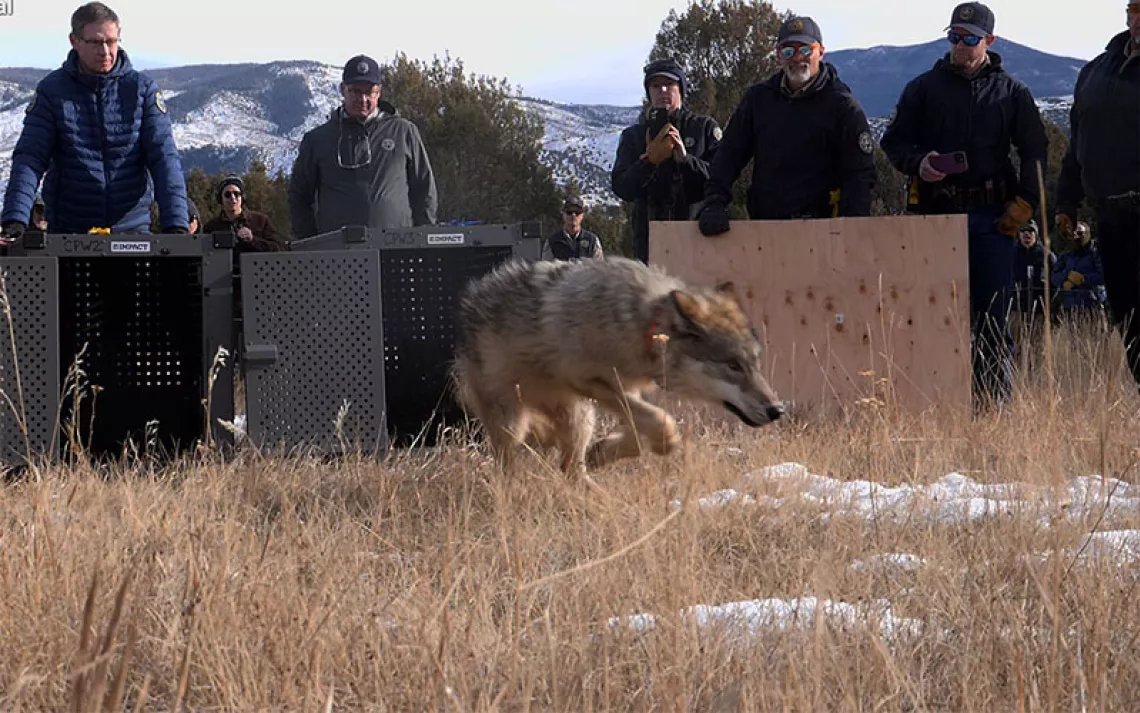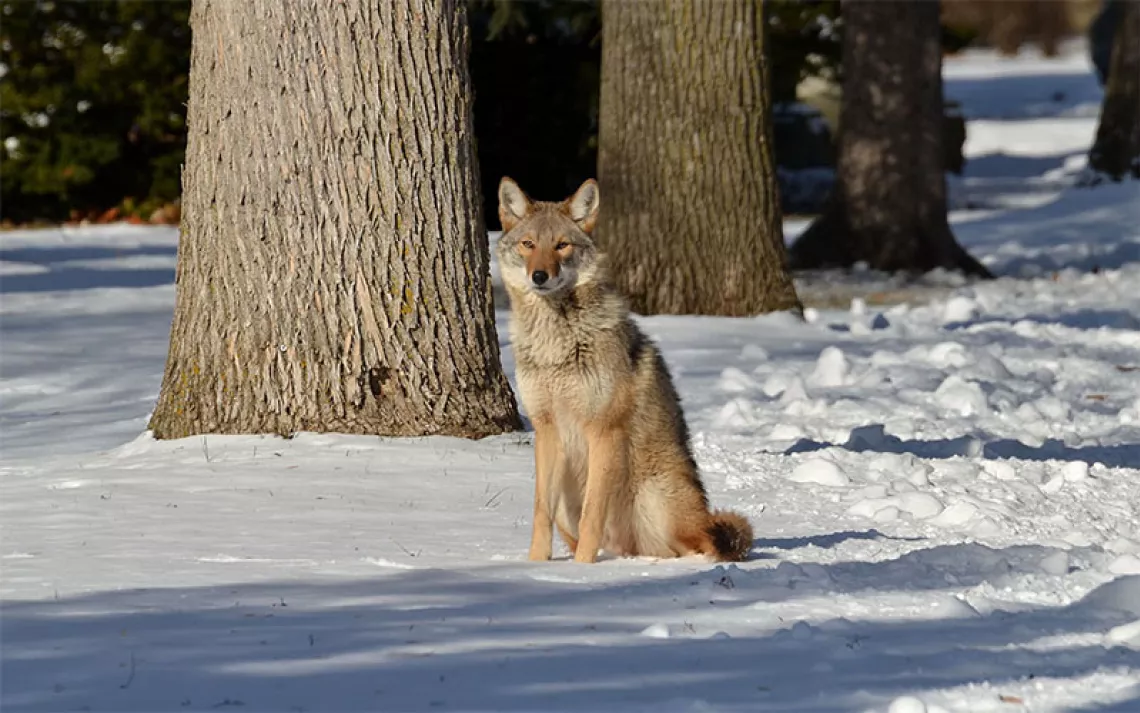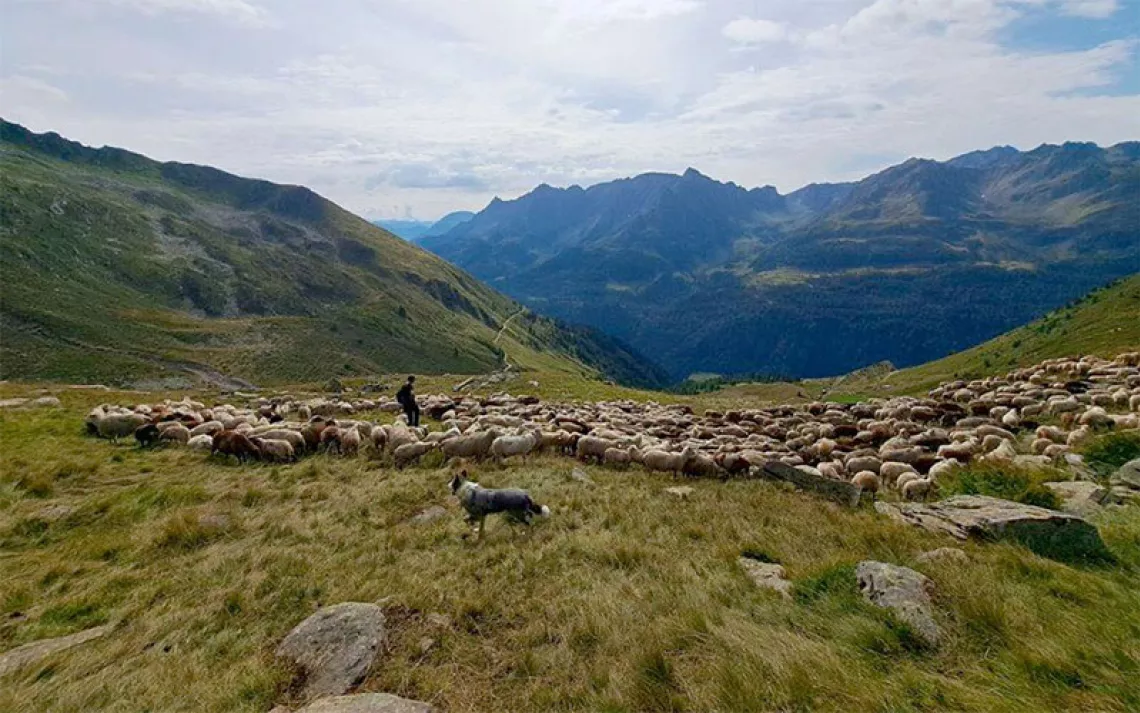Ahead of the Pack
Novel projects bode well for conservationists, ranchers, and wolves
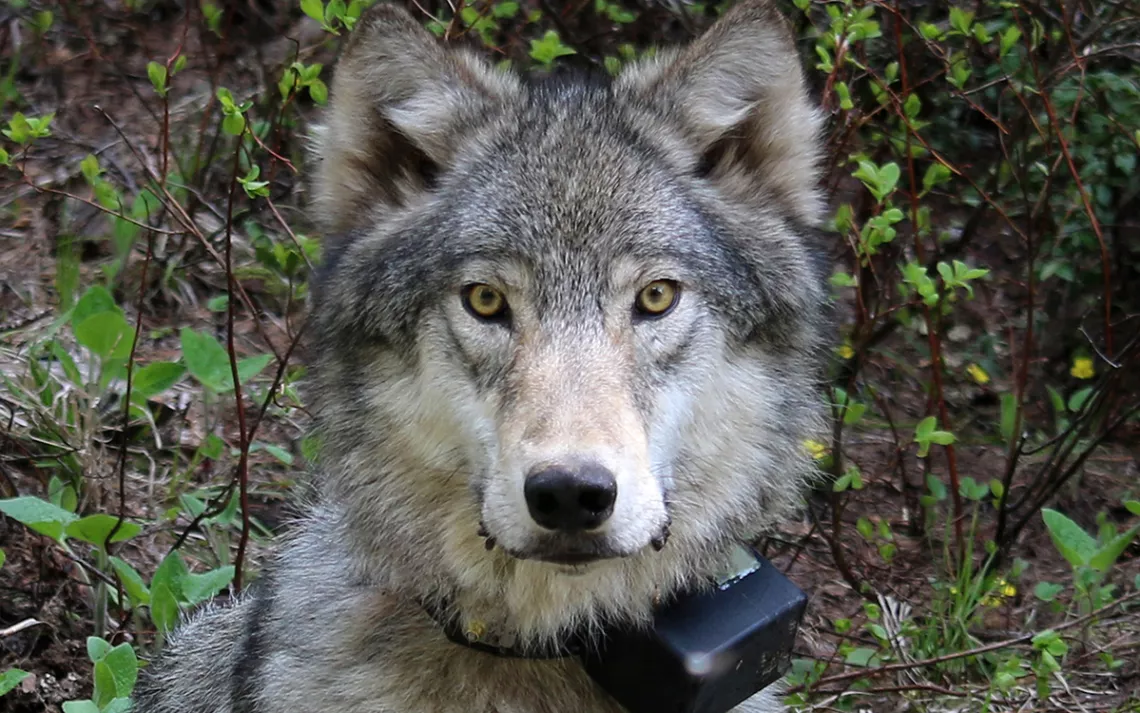
Photos courtesy of the Oregon Department of Fish and Wildlife
It’s after lunch, and the folding chairs are uncomfortable, but Cameron Krebs has the attention of every person in the room. A collection of ranchers, agency representatives, and at least one writer have gathered at the Jackson County Expo in southern Oregon to learn about effective nonlethal strategies for deterring predators—in particular, gray wolves, which have made a dramatic return to the region.
“I don’t hate wolves, and I’m not a wolf advocate,” Krebs says, shrugging matter-of-factly. “But the wolves are here, and they’re not going anywhere.”
Krebs is a fifth-generation rancher who returned to his family’s ranch full-time in 2009. His sheep and cattle operation spans five counties in the northeast corner of the state and includes some Forest Service grazing allotments. Northeast Oregon is home to most of the state’s wolves and is the epicenter of Oregon’s wolf diaspora.
Krebs describes a process of continual adaptation in response to shifting wildlife policies and a changing landscape. For 10 years he has penned his sheep every single night, and his herders count their flocks five times a day. They use guard dogs in two lines of defense: one group outside the night pens, one inside them. He stresses the importance of a human presence, whether in the form of range riders or voices broadcast over loudspeakers.
“Every time you get out of your truck, go pee on a post,” he tells the room. People chuckle, but Krebs is not kidding.
In 10 years, despite the increasing number of wolves, Krebs has not lost a single sheep inside the night pens. By his calculations, seven saved sheep pays for the cost of a single pen. (Before, he was losing an average of one to two sheep a week.) Even so, he has to keep one step ahead of the “enemy.” Right now he is experimenting with “bark collars,” which light up when his guardian dogs bark, making wolves think twice about attacking them.
“You can’t do what Grandpa did,” says Krebs. “Change is a mindset.” And change, Krebs emphasizes, is exactly what livestock producers will need to do to coexist with wolves.
After a relentless campaign of bounty hunting, trapping, and poisoning eradicated the gray wolf from most of its North American range, wolves were famously reintroduced to Yellowstone National Park and central Idaho in the mid-1990s. Since then, wolves have been slowly repopulating the Western states.
In 1999, the first radio-collared wolf stepped foot into northeast Oregon. In 2000, two Idaho wolves met their demise in Oregon: One was shot, the other struck by a vehicle. By 2008, wolves were reproducing in the state, and today Oregon supports an estimated 137 individuals and 16 packs.
At the Jackson County workshop, ranchers are introduced to a host of strategies to keep wolves away from their livestock. Topping the list is “bone pile” removal—getting rid of animal carcasses, which attract scavengers, including wolves. Other strategies include scaring wolves with lights and loud noises and dissuading them with fladry—temporary fencing composed of triangular flags that flap in the slightest breeze. (For an extra disincentive, fladry can be electrified.)
Krebs and the other presenters—who include reps from Wildlife Services, the Oregon Department of Fish and Wildlife, and conservation groups—also advocate for animal husbandry techniques that make livestock less vulnerable to wolves. For example, Krebs feeds his cattle high-quality minerals at dusk. Not only does this improve their health, but it also encourages them to stay bunched up all night, making them less of a target for predators.
Krebs makes a compelling case. But can these methods work across the broader landscape?
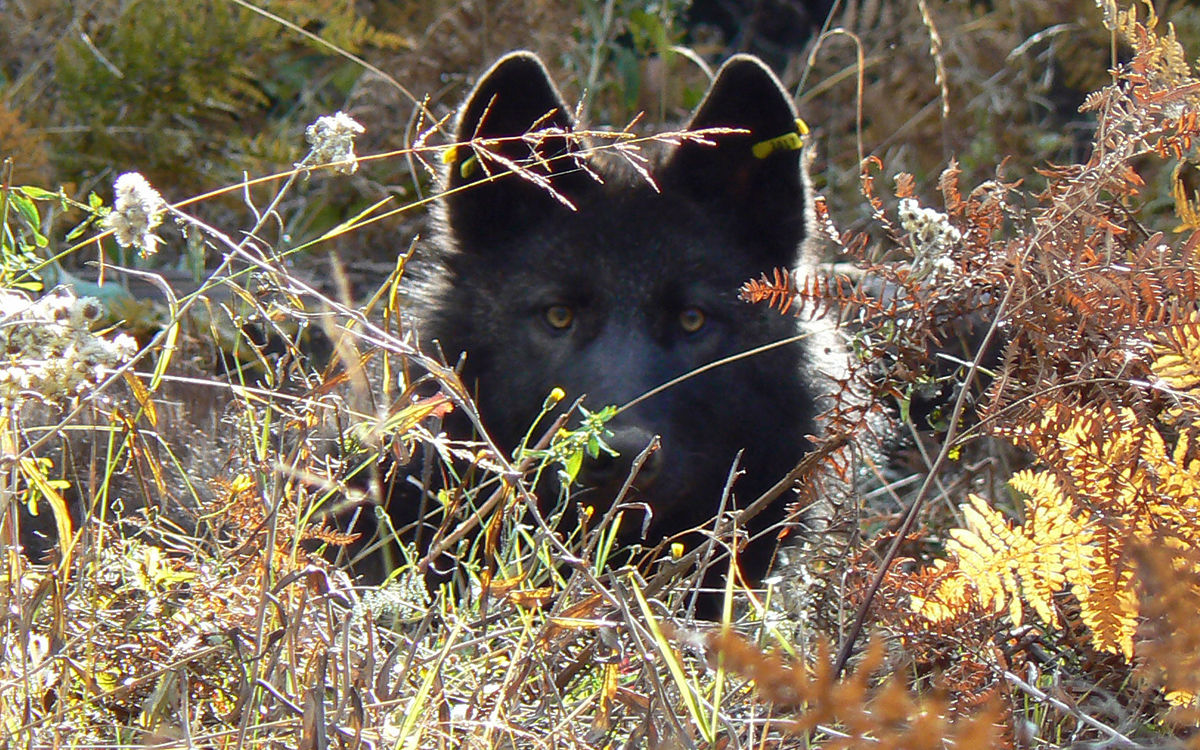
A Test Case in the Heart of Wolf Country
Blaine County, Idaho, has one of the highest concentrations of domestic sheep on public lands in the country. The rugged, remote, and mountainous terrain is also ideal wolf habitat.
In 2007, a sheepherder brought his flock right into the middle of the Phantom Hill pack’s territory. Within 24 hours, wolves had killed several sheep.
US Fish and Wildlife responded, and a kill order for the wolves was approved, as was standard protocol for the rest of the state. But Blaine County residents resisted.
A steering committee formed, consisting of area ranchers, wolf advocates, government reps, and agency biologists, and in 2008 the Wood River Wolf Project was born to test whether nonlethal tools could work to deter predators.
“The scientific literature said you can’t use these tools across large landscapes,” says Suzanne Stone, Northern Rockies wolf coordinator for Defenders of Wildlife and a sponsor of the Wood River Wolf Project. “But it hadn’t really been tried before.”
They upped the number of guardian dogs, deployed electrified “turbo-fladry” and put on “wolf discos” complete with flashing lights and music. Critically, they hired Spanish-speaking field technicians to work with the Peruvian sheepherders, giving them intel about wolf locations and movements and recommending specific strategies. Ranchers were skeptical at first, but as time passed and the methods proved successful, more joined in on the project.
The original project area consisted of 147,770 acres; in 2011, it was expanded to 282,600 acres.
In the first seven years of the project, livestock losses were 90 percent lower than in the rest of the state. Only 46 sheep have been killed by wolves since the project launched. (One wolf has also been killed within the project area.) In contrast, between 2008 and 2014, the state of Idaho killed 576 wolves that had attacked livestock.
Although it may seem easier to simply pick up the phone and call Wildlife Services, lethal control can work against you, warns Stone. “If you kill wolves, but it’s attractive habitat, they’ll keep coming back,” she says.
Stable packs are also more predictable, and hence, easier to manage with nonlethal deterrents. Knowing where the wolves are likely to be can help ranchers better plan their strategies—for example, avoiding a known den site in spring.
Like Krebs, Stone stresses that to be effective, the strategies must be adapted to the situation, time of year, and terrain. It’s not just a matter of setting up lights and forgetting about them. As the wolf adapts, so must the livestock producer.
Stone and others are striving to export these strategies—and more importantly, the mindset—to other regions, ideally, before wolves even arrive.
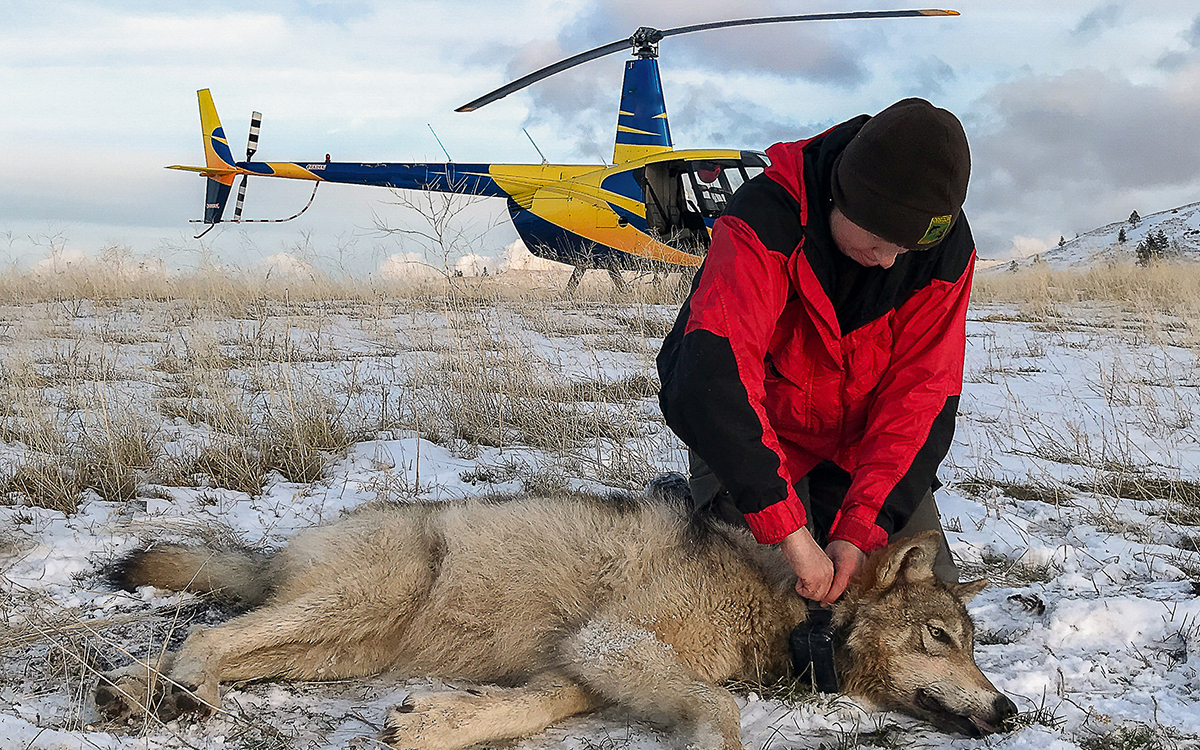
Charismatic Wildlife, or Cold-Blooded Killer?
OR7, a.k.a. “Journey,” is arguably the most famous wolf in Oregon. The Department of Fish and Wildlife fitted him with a radio collar while he was part of the Imnaha pack in Wallowa County, but he first made waves in 2011, when he was tracked in Northern California. OR7 looped back up into southern Oregon and, somewhat miraculously, found a mate. The pair had their first litter in 2014, and ODFW formally designated the Rogue pack.
In October 2016, after an area rancher suffered the first losses from the Rogue pack, ODFW designated an “Area of Depredating Wolves” straddling two counties in southwest Oregon. In 2018, the Rogue pack killed 11 cows and dogs, making it the deadliest group of wolves in the state by far.
“The only pack we have in the southwest [Oregon] region is a depredating pack,” says Steve Niemela, a wildlife biologist for ODFW. “But if you zoom out, most packs are not depredating livestock.”
Fortunately for OR7 and his offspring, the Rogue pack is safe from lethal control—for now. In Oregon, wolves are divided into two groups. Wolves in the western half of the state are protected under the federal Endangered Species Act and managed under the state’s “Phase I” goals. Wolves in eastern Oregon are under “Phase III” management and can be killed if they attack livestock more than once.
Wolves kill not with a decisive bite to the neck, such as a cougar delivers, but through a series of crushing bites to the hindquarters and back legs. They dart in, bite, and release. A calf that has been attacked by wolves is likely to have tell-tale chunks of flesh missing from its hindquarters.
Ranchers argue that they don’t just suffer monetary losses but take an emotional hit when their cattle, sheep, or dogs are injured and killed.
“Ranchers generally care very much for the quality of life of their animals,” says Karin Vardaman, executive director for Working Circle Proactive Stewardship.
Part of the trick to getting ranchers on board with nonlethal controls is acknowledging the very real threat they face when wolves return. Both Stone and Vardaman stress the importance of finding common ground.
“Basically it comes down to the fact that we don't want to see wolves die because of cattle, and the ranchers don’t want to see cattle die because of the wolves,” says Vardaman. “So how do we go from there in a respectful way and understand where people's values are?”
Unfortunately, most states have followed a predictable pattern: The wolves come in; the conservation groups celebrate. Wolves are protected, and populations grow. Depredations begin, and ranchers protest. The agencies launch an aggressive management response and start killing wolves. The conservation groups rage, and the finger-pointing begins.
“Here we are 27, 28 years later, and the conflict and the divisiveness are just as bad, if not worse,” says Vardaman.
Working Circle, a collaboration between the California Wolf Center and Northern California ranchers, is trying to break the self-destructive pattern by empowering ranchers to make choices that will benefit both livestock and wolves. Frustrated with the impasse between conservation groups and ranchers, Vardaman decided to leap over the divide and learn about ranchers and their operations.
The premise of Working Circle is not to tell ranchers what to do, but to provide information and training on nonlethal deterrents while taking advantage of the knowledge ranchers already have about their land and their animals.
Working Circle promotes the use of trained range stewards, who are ideally family members or ranch hands. Range stewards learn about wolf ecology and ways to handle and herd livestock that help make them less vulnerable to predators.
“It’s not about managing wolves; it’s about managing cattle,” says Vardaman.
Some attend a week-long workshop in the Tom Miner basin in Montana. This intense landscape, just outside Yellowstone National Park, is home to wolves, grizzly bears, elk, bison—and livestock. There, ranchers like Hilary Anderson have laid the groundwork for a model of coexistence using a combination of range riding, herd management, fladry, tracking, and the removal of animal carcasses.
Breanna Owens, a rancher who raises sheep and cattle in Northern California, is program director for Working Circle. She works with area producers, encouraging them to test nonlethal strategies, and also promotes grazing methods that serve to enhance soil and vegetation and improve habitat for both livestock and wildlife.
Working Circle’s holistic approach requires understanding the complex relationships among predator, prey, and the land itself. The goal is to make domestic livestock less vulnerable than the native deer, elk, or bison that share the landscape.
“With elk, their response is to run as a herd, and oftentimes the young or old will get taken down,” says Owens. Bison, on the other hand, tend to stand their ground. If you can manage cattle to behave more like bison, wolves are more likely to pursue elk and leave the cows alone.
Last spring, Working Circle hosted a series of workshops in Lassen County that focused on different aspects of systems-based and adaptive management.
“You can’t just say, ‘You all should just start herding your cattle.’ That doesn’t make sense to people,” says Owens. “But if you start breaking down the principles of livestock management and ecology, people can start to develop their own solutions that are rooted in these principles.”
It doesn’t happen overnight, Owens says, and there are many hurdles to overcome, starting with the rancher’s mindset and bottom line. She, Stone, and Vardaman all stress the importance of starting well before the wolves come.
“There are ranchers in Northern California and Nevada and Utah and other states where there are no wolves and they're still using these methods because it's better for the soil, better for biodiversity of the plants, and better for the cattle,” says Stone.
ODFW updated its wolf-management plan for Oregon in 2019. Although the plan tightened the requirements for lethal control in the eastern part of the state—a producer must have at least two documented incidents of wolves killing livestock within a nine-month period, and must have tried nonlethal techniques before requesting a kill order—several conservation groups refused to support the plan, stating that it opens the door to more killing (and eventual hunting) of wolves.
Stone calls the management plan “a bit thin,” but she is heartened that ODFW is widening the role for nonlethal strategies and inviting people such as Krebs and Owens to show ranchers a different way. (Wildlife Services, long criticized by many conservation groups as a killing machine, has even hired a full-time nonlethal specialist for its southwest Oregon district.) Stone hopes that Colorado, which confirmed the presence of a single gray wolf this summer and is considering a ballot initiative to reintroduce wolves, will take Oregon’s model and improve upon it.
Meanwhile, Working Circle is expanding its work into southern Oregon and Colorado.
“We know the Working Circle model works,” says Vardaman. “Colorado could be the place to demonstrate it fully, and then maybe it can reflect back to other states like Wyoming and Idaho.”
The hope is that by the time wolves are successful enough to have their protections removed, even ranchers will believe there is a place for them.
 The Magazine of The Sierra Club
The Magazine of The Sierra Club

